Unlike southern Idaho, north Idaho is thankfully devoid of poisonous snakes. The snakes that do live in the forested region of the north are harmless to humans and the ones you’ll most likely encounter are garter snakes.
Two types of garter snakes live in Boundary County–the common garter snake and the western terrestrial garter snake. Both have three cream to yellow stripes running down their length, with one dorsal (back) stripe and one on each side. The stripes on the western terrestrial garter snake can appear wavy because dark, pencil eraser-sized spots scattered over its back overlap the edges of the stripes.
Another way to tell the two snakes apart is the color between the stripes–the common garter snake is very dark to black while the western terrestrial garter snake is olive to greenish gray. Additionally, some common garter snakes have red spots on the sides of their bodies.
Both survive on a wide variety of prey. They both prey on earthworms, slugs, leeches, frogs, fish and mice. The western terrestrial garter snake also preys on tadpoles, snails, lizards, insects and carrion (roadkill) while the common garter snake rounds out its diet with toads, salamanders, some birds and the occasional insect or spider. Young common garter snakes primarily eat earthworms until they’re large enough to attack more challenging prey.
The garter snake’s habitat is as varied as its diet–anywhere associated with water, such as marshes, streams and ponds. They can also be found in open meadows and even swimming. Common garter snakes also venture into coniferous forests. The wide-range of habitats that garter snakes occupy, along with their varied diet makes it easy to understand why they are the most common snake in Idaho. Common garter snakes are also one of the most widely distributed reptiles in North America.
Since snakes are reptiles, they can either lay eggs or bear live young. Most snakes in Idaho are egg layers but both garter snakes bear live young, typically between July and September. The western terrestrial garter snake bears four to nine young while the common garter snake averages 13 to 26 young but has been known to have up to 85 young!
Birth isn’t the only time large quantities of snakes can be found together–snakes often group together during hibernation. Dozens to hundreds of garter snakes may congregate in hibernacula (winter dens) to spend the winter. Garter snakes often hibernate in crevices on south-facing rocky outcrops, which can include a natural rock wall in your yard.
During sweltering summer afternoons, garter snakes take shelter under logs, boards, rocks, leaf piles, firewood piles and anywhere else that is cool. They need the sun to warm their cold-blooded bodies, but they also need to seek shelter on hot days so they don’t overheat. Besides, when they are basking in the sun they are vulnerable to predators like skunks, raccoons, bears, hawks, owls, magpies and crows.
Even though garter snakes are not poisonous to people, they will emit a musky scent and/or fecal matter if they feel threatened by predators, including people.

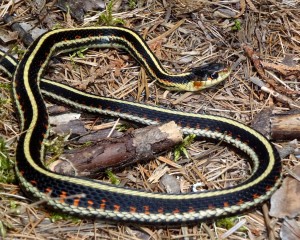
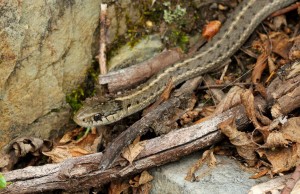
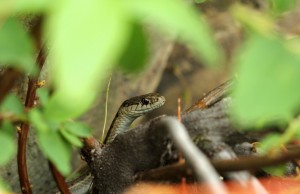
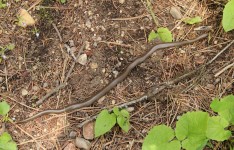

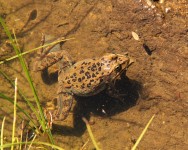
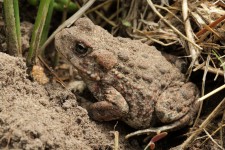
I think there’s at least one of these in my large flower garden, in which I have water features such as small manmade ponds and birdbaths. I don’t know if these snakes can climb, but I’ve often found the agitator in my birdbath moved off center by something that has bumped it or caused it to glide. No deer tracks, so not deer.
My snake is very thin — like a pencil — and very long. It has a black body with some striping, and I found it in one of my ponds one day when the water was low. It scurried out and hid under some plants when I approached. I often see it scurrying away from one burrow and ducking into another, slithering along the footpaths in between. A very sweet and interesting little snake. I never handle it.
I would love to know. could my garter snakes be eating my young gold fish in my pond,as I have have several living near the pond???
Yes. Both survive on a wide variety of prey. They both prey on earthworms, slugs, leeches, frogs, fish and mice. The western terrestrial garter snake also preys on tadpoles, snails, lizards, insects and carrion (roadkill) while the common garter snake rounds out its diet with toads, salamanders, some birds and the occasional insect or spider. Young common garter snakes primarily eat earthworms until they’re large enough to attack more challenging prey.
Oh yes, they love small fish!
Where can I find garter snakes in postfalls,Idaho near cour’dal ane
Hi Austin,
I’ve mainly found garter snakes while hiking trails and they usually have been basking in the sun.
I can’t suggest a specific location but instead find trails with sunny exposure where the snakes might be basking.
Good luck!
Laura
Just found a nest of 5 common garders today in Cocolalla They are beautiful.
I work for landfill in San Antonio, Tx. There two water holes where frogs and toads breed and there are 2 of the fatest little gartersnakes living in them. there is one in each hole. Life is abundant there for the amphibians and the snakes. I wish I could post a pic of both.
That would be neat to see!
thank you this article!! you helped me identify a lovely little snake at the back of my property in kootenai county today. he was flicking his bright red tongue at me and wiggled away when i petted him. a common garter snake.